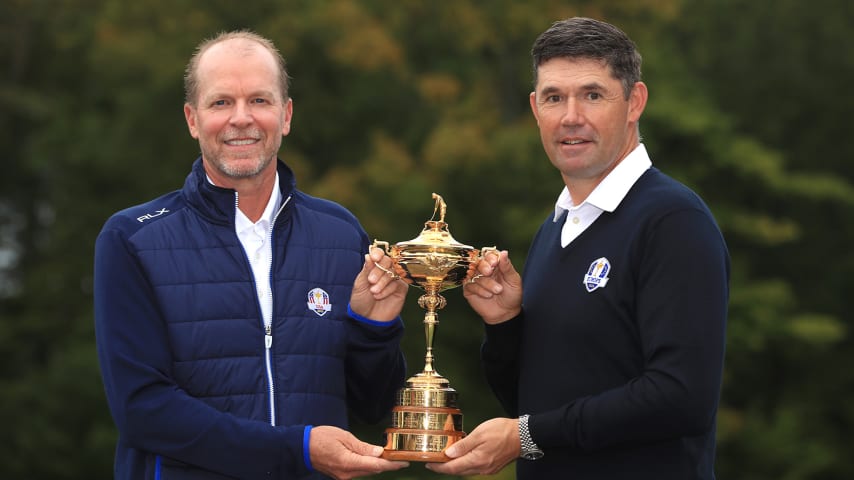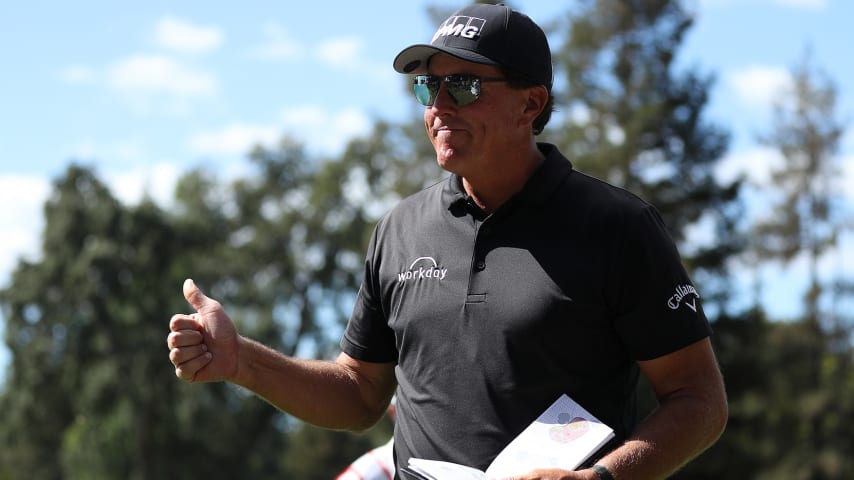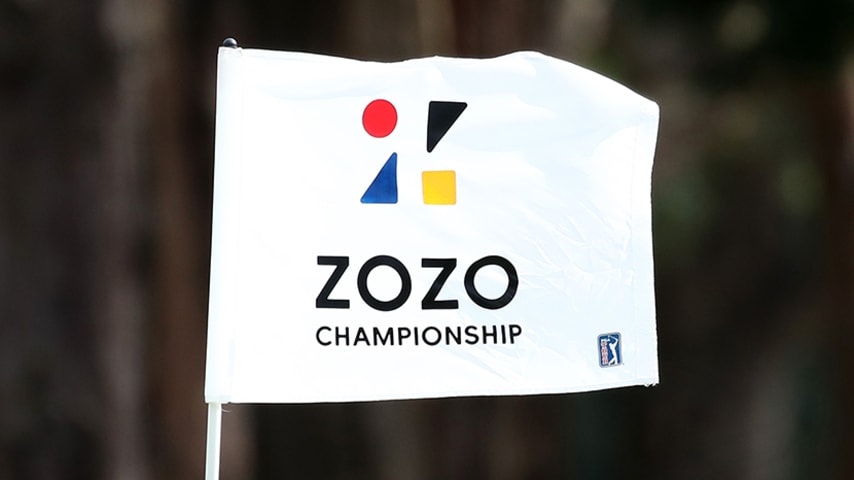Five Things to Know: Whistling Straits
11 Min Read

SHEBOYGAN, WI - AUGUST 16: Justin Rose of England plays his shot from the seventh tee during the final round of the 2015 PGA Championship at Whistling Straits on August 16, 2015 in Sheboygan, Wisconsin. (Photo by Tom Pennington/Getty Images)
This year’s Ryder Cup venue is a man-made homage to the links of Ireland
Written by Sean Martin
This year’s Ryder Cup venue is a man-made homage to the links of Ireland
After an extra year of anticipation, the Ryder Cup is back. It’s been three long years since Europe dominated the United States on a tight and penal Le Golf National layout outside Paris, winning 17 1/2 - 10 1/2. The United States has the benefit of being back on home soil this week as it tries to avenge the loss.
The U.S. has outscored Europe, 47-37, in the last three Ryder Cups in the New World. Only one historic collapse on the final day in 2012 kept the U.S. from sweeping all three competitions. Big, Midwestern ballparks have been a big part of the United States’ home success.
Whistling Straits, located about an hour north of Milwaukee, fits that description. It was the longest course in major history when it hosted the 2004 PGA Championship. The PGA has been played three times at Whistling Straits, and victories by Jason Day and Vijay Singh, as well as close calls by Bubba Watson and Dustin Johnson, prove that distance is an advantage there. Pete Dye’s design also has done a good job of identifying the best player, as all three winners at Whistling Straits took over the top spot in the world ranking shortly after their win.
While the course setup may look familiar this week, there are few venues that compare with the site of this year’s Ryder Cup. “In my lifetime, I’ve never seen anything like this. Anyplace. Period,” said Dye. He transformed a flat site on the shores of Lake Michigan into one that features dramatic dunes reminiscent of the linksland of Ireland. The course’s lakeside views and Dye’s distinctive design philosophy should only add intrigue to this long-awaited showdown between the United States and Europe.
Here’s 5 Things to Know about Whistling Straits before the Ryder Cup begins:
1. THAT SINK-ING FEELING
Whistling Straits is a home venue for the U.S. team, but the family behind the course traces its lineage back to the Old World.
The Kohler Co. was founded in 1873 by a 29-year-old Austrian immigrant named John Michael Kohler. He started with a small foundry that cast farm equipment before creating the company’s first bathtub by enameling an iron trough and standing it on four feet. The Kohler Co. quickly became a leader in the construction and design of plumbing fixtures.
Herb Kohler, the man responsible for adding golf courses to the family’s business portfolio, became CEO in 1972.
In the late 1970s, he transformed the American Club – which had once served as a dormitory for Kohler Co.’s immigrant artisans and craftsmen – into a resort. Visitors kept making one suggestion, however.
“You consider yourself an upscale resort hotel but you don’t have a golf course. Do it,” Herb Kohler recalled of his guests demands. Herb, a mid-handicap player with an outsized passion for the game, was happy to indulge their desire. He hired Dye for the job.
The controversial, and iconoclastic, architect was the perfect fit for a company focused on design and innovation. Kohler’s first course, Blackwolf Run, opened in 1988. The tee sheet quickly filled, and even another 18 holes couldn’t keep pace with the demand.
That sent Herb Kohler searching for an additional site. His quest brought him to a piece of land on the shores of Lake Michigan that had fallen into disuse. The two-mile stretch of shoreline was once owned by the U.S. Army, which used it as an anti-aircraft training facility in the 1950s.
“An old runway still peeked through flat, grassy terrain, and dairy grazing lands surrounded the site on three sides,” Dye wrote in his autobiography. “The fourth side bordered the chilly waters of Lake Michigan and featured 70-foot bluffs.
“When I first walked the land, I was mesmerized by the potential for several lakeside holes.”
He started work on Whistling Straits in 1995. The course opened three years later, in the same year that Se Ri Pak beat amateur Jenny Chuasiriporn in a playoff to win the 1998 U.S. Women’s Open at Blackwolf Run. Pak’s victory was the catalyst that led to the success of so many of her South Korean countrywomen on the LPGA.
2. ODE TO IRELAND
Whistling Straits’ heaving dunes and water views may feel familiar to the Europeans, as well. The course pays homage to the classic links built on Ireland’s dramatic coastal landscapes.
“I want the course to look like Ballybunion,” Dye recalled Kohler proclaiming, referring to the famous Irish links that they often played on golf trips abroad.
“We did share a love for the natural look of the celebrated golf courses of Ireland, shaped among huge sand dunes that rose like prehistoric monsters along the coastline,” Dye wrote.
All of Whistling Straits’ dunes were made by men, however. The course was molded on a site that Dye described as “flat as a pancake.”
Dye built the dunes by pushing back the lakeside bluffs. That helped preserve the eroding shoreline by producing beaches that could withstand the impact of breaking waves. The dunes were then covered with tons of sand purchased from a nearby farmer and planted with fescue grass to give them a raw, natural look. Construction continued even in the winter, when the heavy equipment could maneuver on the frozen lake.
The huge dunes serve as buffers that hide the adjacent farmland – making it easy to forget one is in rural Wisconsin -- and provide dramatic views of Lake Michigan from every hole.
“Everything you see out there was created,” Dye said. “Every inch of it.”
3. THE LONG OF IT
Whistling Straits was listed at 7,514 yards for the 2004 PGA, making it the longest course in major championship history at the time. It included three par-4s longer than 500 yards (Nos. 8, 15 and 18).
WHISTLING STRAITS' FINISHING STRETCH*
| Hole | Rank | Length (par) | Average |
| 15 | 4 | 518 yards (4) | 4.26 |
| 16 | 18 | 569 yards (5) | 4.62 |
| 17 | 6 | 223 yards (3) | 3.19 |
| 18 | 1 | 520 yards (4) | 4.54 |
* -- from 2015 PGA Championship
The 15th hole kicks off a four-hole finishing stretch that includes two brutal par-4s, a demanding par-3 and one respite, the par-5 16th. A closing trio of a reachable par-5, tricky par-3 and brutish par-4 is a trademark of many of Dye’s most famous designs, including the Stadium Courses at both TPC Sawgrass and PGA West, as well as Kiawah Island.
The 15th hole played to a 4.3 scoring average in 2015, making it the fourth-hardest hole on the course. The par-5 16th was the easiest hole six years ago (4.6 average). It’s followed by the longest par-3 on the course, however, the 223-yard 17th.
There’s an 80-yard difference between Whistling Straits’ shortest one-shotter (the 143-yard 12th) and its longest, as Dye wanted to present players with a variety of shots on these holes, all of which hug the shoreline. Whistling Straits’ penultimate hole isn’t an island green like some of Dye’s famous 17th holes, but it is plenty penal and includes some of his usual visual trickery. With deep bunkers and Lake Michigan to the left, a large, elevated dune obstructs the view of the green’s right side.
“Instead of the player realizing the green is huge, it appears to be a postage stamp,” Dye wrote.
The final hole, named Dyeabolical, played to a 4.54 scoring average in 2015, making it the third-hardest par-4 on TOUR that season (behind only St. Andrews’ Road Hole and Doral’s 18th).
Whistling Straits is listed as a 7,390-yard, par-71 for this year’s Ryder Cup. It played as a par-72 for its three PGA Championships but the 11th hole will be converted from a par-5 to a par-4 for the Ryder Cup.
4. ENTER SANDMAN
“There are bunkers everywhere, in staggering numbers. They snake along fairways, adorn the tops of two-story mounds, hide in seas of fescue rough and cling to the sides of greens.
“The bunkers at Whistling Straits range in size from depressions as small as a bathtub to a 300-yard monstrosity on the par-5 fifth hole.”
That is the colorful description of Whistling Straits’ innumerable bunkers by legendary Wisconsin golf writer Gary D’Amato.
The sands of Whistling Straits come in various shapes and sizes. But how many bunkers dot this Dye design?
No one can say for sure.
Officials at the Kohler Co. tried to count them all on a blown-up aerial photograph. They gave up, though, because there were just too many. “More than 1,000,” became the standard answer.
“The most accurate answer is, ‘We don’t know,’” one Whistling Straits employee told D’Amato.
Golf Digest’s Ron Whitten attempted to arrive at a definitive answer in 2010, before Whistling Straits hosted its second PGA Championship. Using a tool he fashioned from a lamp globe and a hoe handle to mark the bunkers, Whitten spent 11 hours over two days counting Whistling Straits’ traps alongside caddie Bob Palm. Their final answer? Nine hundred and sixty-seven.
According to Whitten, the eighth hole has the most bunkers (102) and the 18th hole has 96. The 12th and 14th holes both have 18 bunkers, tied for the fewest.
There are so many that the gallery often stands in them behind the ropes. But all of them are considered hazards. Every player this week will surely be aware of that, especially after what happened to Johnson 11 years ago. His infraction on the final hole of the 2010 PGA is well-known. But it isn’t the only time that a mishap in one of Whistling Straits’ bunkers had an impact on the final outcome.
Stuart Appleby had made four birdies in his previous five holes when he stepped to the 16th tee in the third round of the 2004 PGA. He made quadruple-bogey on the hole, however, after being penalized four strokes for removing some dead grass from the bunker and grounding his club in the hazard. Appleby finished T17, five shots behind winner Vijay Singh.
“You talk about saving shots in a round of golf,” Appleby said. “I … could have saved four strokes by reading a piece of paper inside the locker room.”
Six years later, Johnson’s two-shot penalty on the 72nd hole kept him out of the playoff between Martin Kaymer and Bubba Watson.
Johnson blew his tee shot on 18 into the fans. Thinking that his ball simply lay in a trampled-down area, he grounded his club before hitting his approach shot. He was informed after completing the hole that his ball actually had been in a small bunker. When Johnson was informed that he’d grounded his club in a bunker, he replied, “What bunker?”
“It never once crossed my mind that I was in a sand trap,” Johnson said. “I just thought I was on a piece of dirt.”
The gallery chanted, “Let him play!” during the long delay as rules officials sorted out the controversy. Alas, he was assessed a penalty and Kaymer went on to beat Watson in the two-man playoff.
5. MAJOR HISTORY
Johnson’s bunker blunder is the most famous moment from the three PGA Championships at Whistling Straits. That overshadows a strong list of champions, however.
All three winners at Whistling Straits became No. 1 in the world shortly after their wins.
PGA CHAMPIONSHIPS AT WHISTLING STRAITS
| Year | Winner | Score |
| 2004 | Vijay Singh | 280 (-8) |
| 2010 | Martin Kaymer | 277 (-11) |
| 2015 | Jason Day | 268 (-20) |
Vijay Singh won the 2004 PGA in a playoff over Justin Leonard and Chris DiMarco. That win, Singh’s third in a major, came in the midst of his finest campaign. He won nine times that year – despite having negative Strokes Gained: Putting for the season – en route to claiming the PGA TOUR’s Player of the Year Award and supplanting Tiger Woods atop the world ranking. It was Singh’s third major title.
His 76 on Sunday was the highest final-round score by a major winner since R.A. Whitcombe in the 1938 Open Championship. Singh didn’t make a birdie on the final day until the first extra hole.
Six years later, it came down to Kaymer and Watson in a playoff. They traded birdies on the first two playoff holes before Watson hit his approach to 18 into the water fronting the green. That allowed Kaymer to play safe and make a bogey for the win. He became World No. 1 after finishing runner-up in the World Golf Championships-Dell Technologies Match Play in February.
Though Kaymer famously endured a slump in the ensuing years, he regained his game in 2014, winning both the U.S. Open and PLAYERS Championship.
The 2015 PGA was a duel between Jordan Spieth, who’d already won two majors that year, and Jason Day. Spieth was trying to join Tiger Woods and Ben Hogan as the only men to win three majors in a single year.
Day had held at least a share of the 54-hole lead in the previous two majors but was still seeking his first Grand Slam title. He also started Sunday with the lead at Whistling Straits. This time, he shot a final-round 67 for a 20-under 268 total, setting the record for lowest score in relation to par in a major. Spieth finished three back.
“It was Jason’s day,” Spieth said. “He played like he’d won seven or eight majors. … It was a stripe show.”
Day followed with six-shot victories in two FedExCup Playoffs events to ascend to the top of the world ranking weeks later.
BECOMING WORLD NO. 1 AFTER WINNING AT WHISTLING
| Year | Winner | Date of win | Became World No. 1 |
| 2004 | Vijay Singh | 8/15/2004 | 9/5/2004 |
| 2010 | Martin Kaymer | 8/15/2010 | 2/27/2011 |
| 2015 | Jason Day | 8/16/2015 | 9/20/2015 |






